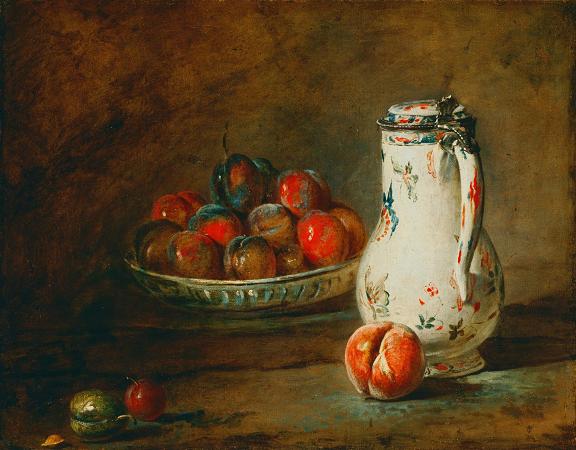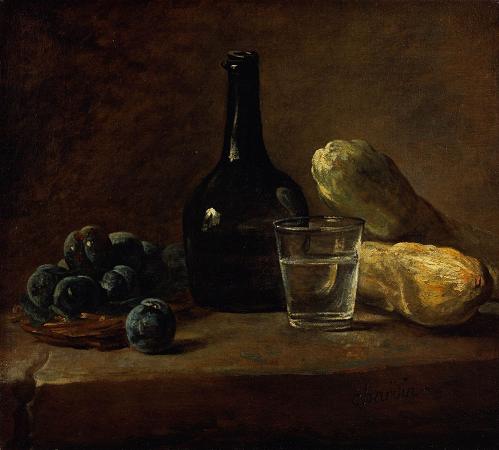Plums. A plum is a fruit of the subgenus Prunus of the genus Prunus. The subgenus is distinguished from other subgenera in the shoots having terminal bud and solitary side buds, the flowers in groups of one to five together on short stems, and the fruit having a groove running down one side and a smooth stone. Mature plum fruit may have a dusty-white waxy coating that gives them a glaucous appearance. This is an epicuticular wax coating and is known as wax bloom. Dried plum fruits are called dried plums or prunes, although, in many countries, prunes are a distinct type of dried plum having a wrinkled appearance. Plums may have been one of the first fruits domesticated by humans. Three of the most abundant cultivars are not found in the wild, only around human settlements: Prunus domestica has been traced to East European and Caucasian mountains, while Prunus salicina and Prunus simonii originated in Asia. Plum remains have been found in Neolithic age archaeological sites along with olives, grapes and figs. The name plum derived from Old English plume or plum, plum tree, which extended from Germanic language or Middle Dutch, and Latin prunum, from Ancient Greek ῦ, believed to be a loanword from Asia Minor. In the late 18th century, the word, plum, was used to indicate something desirable, probably in reference to tasty fruit pieces in desserts. Plums are a diverse group of species. The commercially important plum trees are medium-sized, usually pruned to 5-6 metres height. The tree is of medium hardiness. Without pruning, the trees can reach 12 metres in height and spread across 10 metres. They blossom in different months in different parts of the world; for example, in about January in Taiwan and early April in the United Kingdom. Fruits are usually of medium size, between 2 and 7 centimetres in diameter, globose to oval. The flesh is firm and juicy. The fruit's peel is smooth, with a natural waxy surface that adheres to the flesh. The plum is a drupe, meaning its fleshy fruit surrounds a single hard seed. Plum cultivars include: Damson. Greengage. Mirabelle. Satsuma plum. Victoria. Yellowgage or golden plum. Different plum cultivars. When it flowers in the early spring, a plum tree will be covered in blossoms, and in a good year approximately 50% of the flowers will be pollinated and become plums. Flowering starts after 80 growing degree days. If the weather is too dry, the plums will not develop past a certain stage, but will fall from the tree while still tiny, green buds, and if it is unseasonably wet or if the plums are not harvested as soon as they are ripe, the fruit may develop a fungal condition called brown rot. Brown rot is not toxic, and some affected areas can be cut out of the fruit, but unless the rot is caught immediately, the fruit will no longer be edible. Plum is used as a food plant by the larvae of some Lepidoptera, including November moth, willow beauty and short-cloaked moth. The taste of the plum fruit ranges from sweet to tart; the skin itself may be particularly tart. It is juicy and can be eaten fresh or used in jam-making or other recipes. Plum juice can be fermented into plum wine. In central England, a cider-like alcoholic beverage known as plum jerkum is made from plums. Dried, salted plums are used as a snack, sometimes known as saladito or salao. Various flavors of dried plum are available at Chinese grocers and specialty stores worldwide. They tend to be much drier than the standard prune. Cream, ginseng, spicy, and salty are among the common varieties. Licorice is generally used to intensify the flavor of these plums and is used to make salty plum drinks and toppings for shaved ice or baobing. Pickled plums are another type of preserve available in Asia and international specialty stores. The Japanese variety, called umeboshi, is often used for rice balls, called onigiri or omusubi. The ume, from which umeboshi are made, is more closely related, however, to the apricot than to the plum. In the Balkans, plum is converted into an alcoholic drink named slivovitz. A large number of plums, of the Damson variety, are also grown in Hungary, where they are called szilva and are used to make lekvar, palinka, plum dumplings, and other foods. As with many other members of the rose family, plum kernels contain cyanogenic glycosides, including amygdalin. Prune kernel oil is made from the fleshy inner part of the pit of the plum. Though not available commercially, the wood of plum trees is used by hobbyists and other private woodworkers for musical instruments, knife handles, inlays, and similar small projects.
more...













